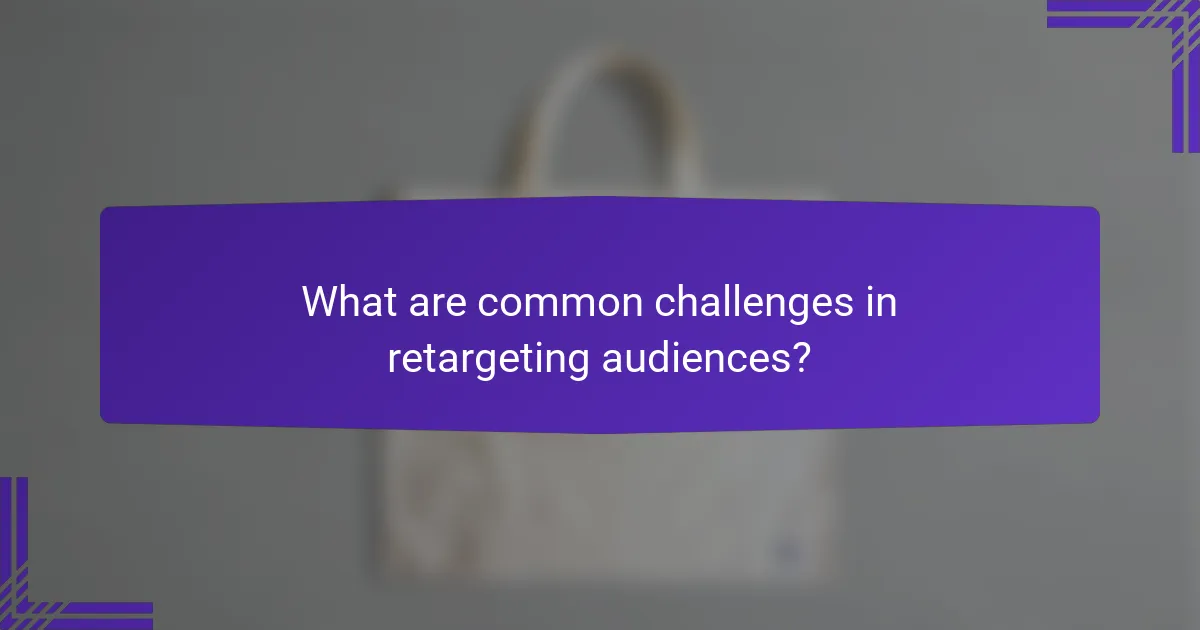Retargeting audiences is a powerful strategy that allows businesses to reconnect with users who have previously engaged with their brand. By implementing best practices and tailored approaches, companies can significantly boost engagement and conversion rates while delivering a personalized experience. However, it is crucial to measure campaign effectiveness and address common challenges such as ad fatigue and privacy concerns to maximize results.

What are the best retargeting strategies for display advertising in Canada?
The best retargeting strategies for display advertising in Canada focus on effectively reaching users who have previously interacted with your brand. By employing tailored approaches, businesses can enhance engagement and conversion rates while ensuring a more personalized experience for potential customers.
Segmenting audiences based on behavior
Segmenting audiences based on behavior involves categorizing users according to their interactions with your website or ads. This can include actions such as page views, time spent on site, or specific product interests. By creating distinct segments, you can tailor your messaging and offers to resonate more effectively with each group.
For example, users who abandoned their shopping carts may receive targeted ads featuring the items they left behind, while those who browsed but did not purchase could see ads highlighting related products. This targeted approach can significantly improve conversion rates.
Using dynamic ads for personalization
Dynamic ads allow for personalized content to be displayed based on user behavior and preferences. These ads automatically adjust their visuals and messaging to reflect the specific interests of each user, making them more relevant and engaging. In Canada, utilizing dynamic ads can enhance the effectiveness of your retargeting efforts.
For instance, if a user viewed a particular jacket on your site, a dynamic ad could showcase that jacket along with complementary items like scarves or hats. This level of personalization can lead to higher click-through rates and increased sales.
Implementing frequency caps
Implementing frequency caps is crucial to avoid overwhelming users with too many ads, which can lead to ad fatigue and negative brand perception. A frequency cap limits the number of times an individual sees your retargeting ads within a specific timeframe, ensuring a balanced exposure.
In practice, setting a cap of 3-5 impressions per week can help maintain user interest without causing annoyance. Regularly monitoring performance metrics will help you adjust these caps as needed to optimize your campaigns.
Leveraging lookalike audiences
Leveraging lookalike audiences involves targeting new users who share similar characteristics with your existing customers. By analyzing data from your current customer base, you can create lookalike segments that are more likely to convert, expanding your reach effectively.
In Canada, platforms like Facebook and Google Ads allow you to create lookalike audiences based on various criteria, such as demographics and online behavior. This strategy can help you tap into new markets while maintaining a focus on users who are likely to be interested in your products or services.

How can I measure the effectiveness of retargeting campaigns?
Measuring the effectiveness of retargeting campaigns involves analyzing various performance metrics to determine their impact on conversions and overall return on investment. Key indicators include conversion rates, return on ad spend (ROAS), and engagement metrics, which provide insights into how well your ads are performing with the target audience.
Tracking conversion rates
Tracking conversion rates is essential for understanding how many users take the desired action after interacting with your retargeting ads. This metric is typically calculated by dividing the number of conversions by the total number of ad interactions, then multiplying by 100 to get a percentage. Aim for conversion rates that align with industry benchmarks, which can vary widely but often fall between 1% and 5% for retargeting efforts.
To effectively track conversion rates, implement tracking pixels or tags on your website. These tools will help you monitor user behavior and attribute conversions accurately to your retargeting campaigns. Regularly reviewing these rates can help you identify trends and optimize your strategies.
Analyzing return on ad spend (ROAS)
Return on ad spend (ROAS) measures the revenue generated for every dollar spent on advertising. To calculate ROAS, divide the total revenue from retargeting by the total ad spend. A ROAS of 4:1, for instance, indicates that for every dollar spent, four dollars in revenue were generated, which is generally considered a strong performance.
When analyzing ROAS, consider the context of your industry and campaign goals. High ROAS might be achievable in some sectors, while others may see lower figures. Regularly assess your ROAS to determine if your retargeting campaigns are financially viable and adjust your budget allocation accordingly.
Utilizing engagement metrics
Engagement metrics provide insights into how users interact with your retargeting ads, including click-through rates (CTR), time spent on site, and bounce rates. High engagement rates often correlate with effective retargeting, indicating that your ads resonate with the audience. Aim for a CTR of around 0.5% to 2% for retargeting ads, which is typically higher than standard display ads.
To utilize engagement metrics effectively, analyze user behavior on your landing pages after clicking on retargeting ads. Look for patterns that indicate whether users are finding the content relevant and engaging. Adjust your ad creatives and targeting strategies based on these insights to enhance overall campaign performance.

What are common challenges in retargeting audiences?
Common challenges in retargeting audiences include ad fatigue, privacy concerns, and data accuracy issues. These factors can hinder the effectiveness of retargeting campaigns, making it essential to address them for optimal results.
Ad fatigue among users
Ad fatigue occurs when users see the same ads repeatedly, leading to decreased engagement and effectiveness. This can result in users ignoring the ads or developing a negative perception of the brand. To combat ad fatigue, consider rotating ad creatives regularly and varying messaging to maintain user interest.
Implementing frequency caps can also help limit the number of times an individual sees the same ad, ensuring that the audience remains engaged. Testing different formats, such as video or carousel ads, can provide fresh experiences and reduce the likelihood of fatigue.
Privacy concerns and regulations
Privacy concerns are increasingly significant in digital marketing, especially with regulations like GDPR in Europe and CCPA in California. These laws require businesses to be transparent about data collection and usage, which can complicate retargeting efforts. Marketers must ensure they have proper consent from users before tracking their behavior.
To navigate these regulations, consider implementing clear privacy policies and offering users the option to opt-out of tracking. Staying informed about local regulations is crucial to avoid potential fines and maintain consumer trust.
Data accuracy issues
Data accuracy is vital for effective retargeting, as inaccurate data can lead to misguided campaigns. Common issues include outdated user information and incorrect tracking setups, which can skew audience insights. Regularly auditing your data sources and tracking mechanisms can help ensure accuracy.
Utilizing reliable analytics tools can improve data quality and provide actionable insights. Additionally, segmenting audiences based on accurate data can enhance targeting precision and campaign performance, leading to better outcomes.

What tools can enhance retargeting efforts?
Several tools can significantly boost retargeting efforts by enabling targeted ads across various platforms. Utilizing these tools effectively can help businesses reconnect with potential customers and increase conversion rates.
Google Ads for display retargeting
Google Ads is a powerful platform for display retargeting, allowing businesses to show ads to users who have previously visited their website. By using the Google Display Network, advertisers can reach millions of sites and apps, ensuring broad visibility.
To set up retargeting with Google Ads, create a remarketing list based on user behavior, such as page visits or actions taken. It’s essential to segment these lists for tailored messaging, which can improve engagement and conversion rates.
Consider using dynamic ads that automatically adjust content based on user interests. This personalization can lead to higher click-through rates and better ROI.
Facebook Ads for custom audiences
Facebook Ads offers robust options for creating custom audiences based on user interactions with your brand. This includes website visitors, app users, and engagement with previous ads, allowing for precise targeting.
To leverage Facebook’s retargeting capabilities, upload customer lists or use the Facebook pixel to track user actions on your site. This data can help you craft personalized ads that resonate with your audience’s interests.
Utilize A/B testing to refine your ad creatives and messaging. Regularly analyzing performance metrics can help you optimize campaigns for better results.
AdRoll for cross-platform retargeting
AdRoll specializes in cross-platform retargeting, enabling businesses to reach users across various channels, including web, social media, and email. This multi-channel approach can enhance brand recall and drive conversions.
Setting up AdRoll involves integrating it with your website and defining audience segments based on user behavior. The platform’s machine learning algorithms help optimize ad placements and bidding strategies for maximum effectiveness.
Consider using AdRoll’s creative tools to design visually appealing ads that align with your brand. Regularly review campaign performance to adjust strategies and improve engagement rates.

What are the prerequisites for successful retargeting?
Successful retargeting requires a well-defined audience and clear campaign objectives. Establishing these prerequisites helps ensure that your marketing efforts effectively reach the right users with relevant messages.
Building a comprehensive audience list
Creating a comprehensive audience list involves segmenting users based on their interactions with your brand. Consider factors such as website visits, product views, and past purchases to identify potential customers who may be interested in your offerings.
Utilize tools like Google Ads or Facebook Pixel to track user behavior and compile your audience data. Aim for a diverse list that includes both warm leads—those who have shown interest—and cold leads who may need more engagement to convert.
Setting clear campaign objectives
Establishing clear campaign objectives is crucial for guiding your retargeting efforts. Define what you want to achieve, whether it’s increasing conversions, boosting brand awareness, or re-engaging past customers.
Use the SMART criteria—Specific, Measurable, Achievable, Relevant, Time-bound—to frame your objectives. For example, aim to increase sales by a certain percentage within a specific timeframe, which will help you measure success and adjust strategies as needed.
